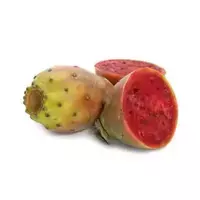Tsabr

One of the most common species of prickly pear, which is also known by the Indian fig name, is the tzabr. The birthplace of this plant is Mexico, although today it is cultivated not only in this country, but also in the Mediterranean - in Egypt, Brazil, India, Chile. It is believed that the tzabr appeared thanks to the fact that Christopher Columbus once brought it to Spain.
Tsabra fruits grow on cacti, the length of which often reaches 3-5 meters. The plant occurs mainly on rocky arid cliffs, with little to no water, but rather quickly. Tsabr is one of those rare varieties of fruit that require absolutely no chemical additives for better growth and fruiting.
Mature fruits of the tsabra can be either white in color or yellow or red in color. By weight, they often reach 400 grams. The fruits of tsabra are rich in minerals and antioxidants, phosphorus, calcium and vitamin C. Due to its chemical composition, tsabra contributes to the purification of the liver, the removal of stones from the kidneys. In addition, it is often used as an analgesic and a natural remedy for burns. However, GI disorders (constipation) are likely if too much of the fruit is consumed.
For culinary purposes, tsabra fruits are used very widely, but their peel is quite thick and covered with a mass of thin miniature needles, which are almost invisible to the human eye. This is precisely what causes the difficulties associated with the use of this fruit. In order to get rid of these thorns, you need to properly clean it.
First of all, you need to wear gloves, rinse the fruits of the tsabra under running water and carefully, using a fork and a knife, cut off the two sides of the fruit of the hat. Having cut the chop in the middle, the fork needs to unfold the peel, separating it from the juicy sweet flesh. By the way, there are a lot of bones in mature fruits - from 100 to 400 in one piece.
Basically, juicy tsabra fruits are usually consumed raw, but often a lot of delicious dishes are prepared from them. For example, numerous confectionery, marmalade and jelly are popular. In addition, jam, sauces, compotes and jams are made on the basis of this prickly fruit.
Pulp and juice are often added to sweets, ice cream, sherbets, yogurts and other types of dairy products. And the fruits of tsabra can be used in the preparation of creams and fruit salads, they are baked and stewed with meat, and also make delicious liqueurs from them.
Tsabra 41 kKal
Energy value of tsabra (Ratio of proteins, fats, carbohydrates - ju):
Proteins: 0.73 g (~ 3 kCal)
Fats: 0.51 g (~ 5 kCal)
Carbohydrates: 5.97 g (~ 24 kCal)
Energy ratio (b | y): 7% | 11% | 58%
 Español
Español Français
Français Português
Português Русский
Русский 简体中文
简体中文 繁體中文
繁體中文 日本語
日本語 한국어
한국어 العربية
العربية Türkçe
Türkçe Қазақ
Қазақ Deutsch
Deutsch Italiano
Italiano Українська
Українська
